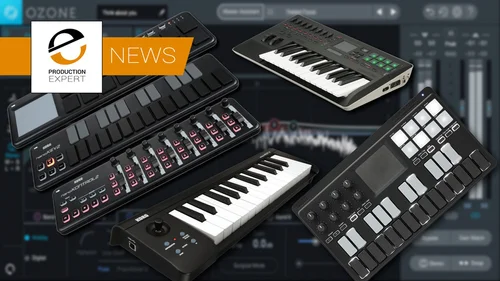- Ozone Elements Auto Tunes
- Ozone Elements Auto Tuner
- Ozone Elements Auto Tuners
- Ozone Elements Auto Tune Kit
Auto-Tune is a pitch correction software developed by Antares that is responsible for the iconic T-Pain vocal effect. Ozone Elements provides a great starting. Antares Auto-Tune EFX+ $ 199.00 Add to cart; Sonible smart:EQ2 $ 129.00 Add to cart; FLEA MICROPHONES 47 WITH EF12 $ 4,075.00 Add to cart; Pro Tools ¦ Ultimate Pro Tools HDX Core Bundle $ 5,799.00 Add to cart; iZotope Ozone 9 Standard Mastering Suite $ 249.00 Add to cart; iZotope Nectar 3 Plus $ 249.00 Add to cart; Apogee Control Remote $ 195. Vocal Assistant: Unmask talks to other iZotope plug-ins to send information and clean up audio in your mix that's clashing with your vocal. You can visualize the Unmasking via a new EQ window in Neutron, Relay, or Nectar 3, and control the effect with a new Amount slider.
1. Xfer Records Serum
Serum is a wavetable synthesizer produced by Xfer Records that lets you create, import, edit, and morph wavetables. It boasts a workflow-oriented interface that makes creating and altering sounds fun, as opposed to tedious. If you’re looking for a versatile multi-purpose synth, Serum is an excellent option.
This synth delivers two ultra-clean oscillators with 16 voices per oscillator, click-and-drag modulation application, tons of different filters, and ten built-in audio effects. Serum’s popularity makes it a go-to synth when collaborating with other artists.
AutoZone is your source for auto parts, accessories and advice. Get parts fast with Free Next Day Delivery and Free Store Pick Up at over 5,700 locations.
Elements is ideal for beginners and beginning producers that are also vocalists, or for seasoned mix engineers who want to take advantage of the precision of the machine learning’s surgical EQ. IZotope caliber effects and a convincing auto-tune that doesn’t add a bunch of artifacts, all of which sound natural, probably due to the machine. Well, almost 😀 Izotope, perhaps known best for their Ozone plugins have provided this free treat to download. Add a touch of vintage flair to your tracks with a plug-in that’s part time machine. IZotope’s Vinyl uses advanced filtering, modeling and resampling to create an authentic “vinyl” simulation, as if the audio was a record.
2. Spectrasonics Omnisphere
Omnisphere brings together many different types of synthesis to create a truly unique software instrument. It includes over 14,000 sounds, 58 effects units, and an excellent patch sorting system and search bar. If you like using presets, you’ll find no shortage of them using Omnisphere.
Believe it or not, Omnisphere is the only software synth in the world to offer a Hardware Synth Integration feature. You can control Omnisphere with over 65 well-known hardware synthesizers, which makes using Omnisphere a very tactile experience.

For more synth recommendations, check out '5 of the Best Plugin Synths on the Market.'
3. Native Instruments Kontakt 6
Kontakt is a sampler that provides you with access to over 55+ GB of detailed, creative, and expressive software instruments. It powers the biggest selection of sampled instruments available, many of which are available from third-parties.
You can drag and drop your own samples into an instrument’s interface or build your own instruments with sample-editing and instrument-building options. If you’re looking for playable software drums, strings, brass, keys, guitar, bass, and more, it’s worth experimenting with Kontakt.
4. XLN Audio Addictive Drums
Recording drums is a nuisance. It can take a tremendous amount of time, energy, and money to record a studio drummer. A lot of producers steer clear of recording live drummers because of the convincing realism and quality that drum production studios like Addictive Drums 2 are capable of.
Whether you produce rock, pop, indie, jazz, electronic, or other styles of music, Addictive Drum 2 will deliver the samples, editing functions, mixing functions, and rhythmic patterns you're looking for.
5. Celemony Melodyne 4 Editor
Celemony’s Melodyne improves pitch accuracy without the robotic sound characteristic of Auto-Tune. If a vocalist falls out of key a few times throughout their recorded performance, Melodyne may be the answer.
Thanks to Melodyne’s user-friendly pitch editor window, you can easily click and drag blobs (segments of audio files) to affect their pitch and time. The built-in Pitch Drift and Pitch Modulation tools let you control pitch drift and vibrato.
- Sound
- Features
- Ease Of Use
iZotope Nectar Elements review
An impressive third iteration to the series. Its machine learning technology is able to produce some effective comprehensive processing to vocals.
Pros:
– Quick workflow
– Natural sounding
Ozone Elements Auto Tunes
Cons:
– It makes mixing engineers obsolete (just kidding… kinda!)
iZotope has updated their vocal processing suite Nectar (see our good old Nectar review) to Nectar Elements on July 11. This new (and much better looking) release boasts its Vocal Assistant, which is iZotope’s new machine learning tech, listening and analyzing incoming audio to set the optimal settings.
Nectar Elements’ Vocal Assistant asks for the style of vocal (Vintage, Modern, or Dialogue) and intensity of the processing (Light, Moderate, or Aggressive) before analyzing incoming audio.
After analysis is complete, there really any ways users can customize the controls aside from simply adjusting the intensity of the six parameters – so, to an extent, what you’re stuck with is what you’re stuck with. But, it’s easy to hit the start over button at the top and re-analyze choosing different settings to get a feel for which style might work best for your vocal.

Nectar’s Assistant processes incoming audio to determine the best settings.
Now the important question: is iZotope’s new Vocal Assistant better than a real mix engineer? Can it hear what mix engineers cannot? Has machine learning already overtaken us? Will all jobs become automated? I’m here to unpack the extent to which each parameter’s function is convincing and effective, and which you should probably just turn off use your DAW’s plugin or a third party plugin to more finely control the sound.
The Nectar Elements interface, with six control parameters and equalizer spectrum graph display.
Ozone Elements Auto Tuner
Pitch
The pitch control is defaults to off, which I certainly appreciate in this over-tuned world. At 1.0x and 0.8x range it’s actually quite transparent and not too obvious. At 2.0x you can get some Kanye/T-Pain level pitch tuning effects. Again, there isn’t any under the hood settings with Elements as they were aiming to maximize speed and efficiency, so there aren’t any options for settings up a particular scale.
Clarity
The clarity knob adjusts the gain on the subtractive EQ bands set by Vocal Assistant. The AI does a pretty good job of analyzing the incoming signal, and the subtractive EQ’s cuts tend to accentuate the good parts of the vocal and remove mud and non-vocal sonic information from the signal. Set on the maximum (2.0x) and with intensity of processing set on moderate or aggressive, vocals can certainly start to sound over-processed or too reduced. However, the higher intensity settings do come in handy when processing background vocals and other layers where you want some discerning frequencies but still need to leave a lot of space for other voices and elements. For dialogue and spoken word, Clarity cleaned up some of the mud in the mids, weird mic quirks, and some of the harshness in the highs. I generally liked and agreed with most if not all of the locations for surgical EQ cuts the clarity module would make.
De-ess
The de-esser is really quite subtle, I was impressed. It preserves the upper frequencies that need preserving and discretely removes harsh material from the highs and sibilance frequency regions. The de-essers action sounded natural, and I was impressed at the precision that it could identify which frequencies would be too harsh.
Ozone Elements Auto Tuners
Dynamics

The dynamics effect is basically a thick, gluey compressor. In the 1.0x range, it’s good at catching extraneous peaks and making sure the vocal doesn’t pop out at the listener too much. At the maximum 2.0x, it sounds very glued together, and would sound great for those genres and vocalists desire that highly-compressed vocal effect.
It’s also quite good at identifying the vocal in the mix and preserving the vocal compressing so much other non-vocal noise or elements, to an extent, it brings down the other elements whilst keeping the vocal front and center.
Tone
This parameter seems to respond a lot to the vintage versus modern setting you set prior to processing – under vintage under extreme settings it makes the vocalist sound like it’s coming from a transistor radio, and at mid 1.0x level settings it is being EQ’ed towards a classical 70’s funk record vocalist. Under modern, extreme settings bring out a pleasing slight distortion in the highs and cuts that preserve more of the low mids, and at 1.0x mid level settings it brings out the highs in a pleasing way, sounding like most modern tracks you hear on the radio today. However, with female vocals, using tone on modern mode could occasionally bring out some unappealing high frequency resonances.
Space
The space module adds a reverb to the signal, under modern providing a verb while vintage produced a more slapback effect, although still reverby. In certain cases, on 2.0x, the most extreme settings, the vintage setting yielded some odd artificial sounding artifacts. Both were quite pleasing and natural to the ear and fit into the mixes I was working on at 0.9-1.0x. I can foresee seasoned mixers reaching for other go to reverbs if they have a different favorite reverb plugin the normally use for a bit more hands on control, but for beginners this one knob works surprisingly well in the majority of mixing situations by adding a convincing space and depth to the vocal.
Conclusion
Nectar Elements is an impressive third iteration to the series. Its machine learning technology is able to produce some effective comprehensive processing to vocals. While it would be nice to switch between vintage, modern, and dialogue modes without having to feed it audio again, the Vocal Assistant is worth the wait.
Elements is ideal for beginners and beginning producers that are also vocalists, or for seasoned mix engineers who want to take advantage of the precision of the machine learning’s surgical EQ. iZotope caliber effects and a convincing auto-tune that doesn’t add a bunch of artifacts, all of which sound natural, probably due to the machine learning intelligence that is built into Nectar.
Price & Availability:
Nectar Elements and an updated Elements Suite is available now and will be on sale from July 11-31, 2018.
If you enjoyed this review, you can support our work buying the product through our Buy Now button or clicking here.
- Nectar Elements is available for $99 USD ( reg.129) £87.00 (reg. £119.00), €99.00 (reg. €129.00)
- Elements Suite is available for $149 USD (reg.199)£139.00 (reg. £179.00), €149.00 (reg. €199.00)
Ozone Elements Auto Tune Kit
DISCLOSURE: Our posts may contain affiliate links, meaning when you click the links and make a purchase, we receive a commission.